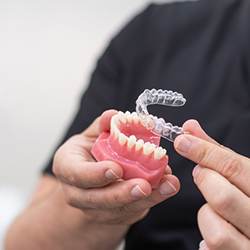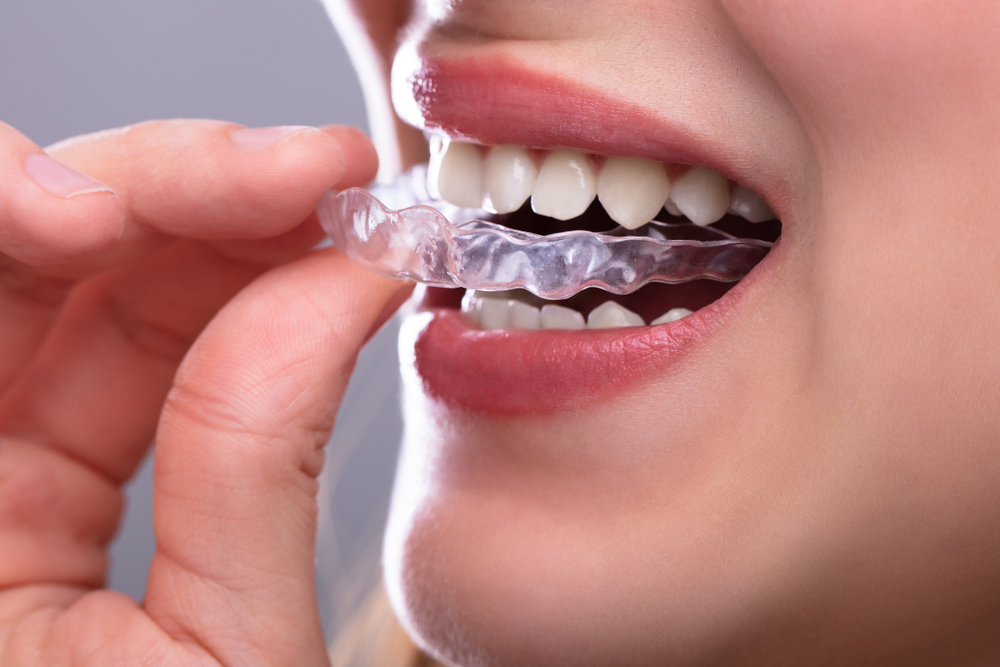Orthodontic Aligners
Orthodontic aligners, commonly known as clear aligners, are a modern alternative to traditional metal braces used in orthodontic treatment. They are designed to straighten teeth, correct bite issues, and improve overall dental alignment. Here’s an overview of aligners in orthodontic treatment:
What Are Clear Aligners?
Clear aligners are custom-made, transparent trays made of plastic material that fit snugly over the teeth. They are designed to gradually move teeth into their desired positions.
How Do Clear Aligners Work?
- Initial Consultation: The orthodontist evaluates the patient’s teeth and creates a treatment plan, often using digital scans or impressions.
- Custom Aligners: A series of aligners are custom-made for the patient. Each set of aligners is typically worn for about 1-2 weeks before moving to the next set.
- Gradual Movement: Each aligner applies gentle, controlled forces to the teeth, gradually shifting them into alignment.
- Regular Check-ups: Periodic visits to the orthodontist ensure the treatment is progressing as planned.


Ideal Candidates for Clear Aligners:
Clear aligners are an effective orthodontic treatment for many people, but certain conditions and characteristics make some individuals particularly well-suited for this type of treatment. Ideal candidates for clear aligners include:
- Mild to Moderate Malocclusions:
- Crowded Teeth: Those with mild to moderate crowding can benefit significantly from clear aligners.
- Spacing Issues: Clear aligners are effective for closing gaps between teeth.
- Overbite, Underbite, and Crossbite: Patients with mild to moderate overbites, underbites, or crossbites can often be treated successfully with clear aligners.
- Adults and Teenagers:
- Mature Dentition: Clear aligners are best suited for individuals who have all their permanent teeth. This generally includes adults and teenagers.
- Older Teens: Responsible older teenagers who are likely to wear their aligners for the required amount of time each day can be good candidates.
- Motivated and Responsible Individuals:
- Compliance: Successful treatment with clear aligners requires wearing them for 20-22 hours a day. Patients must be motivated and disciplined enough to follow this regimen.
- Hygiene Maintenance: Candidates who are committed to maintaining good oral hygiene are ideal, as aligners need to be cleaned regularly.
- Cosmetic Concerns:
- Aesthetic Priority: Individuals who are concerned about the appearance of traditional metal braces may prefer the discreet look of clear aligners.
- Non-Complex Cases:
- Non-Surgical: Clear aligners are typically suitable for non-surgical cases. Complex cases requiring significant tooth movement or jaw realignment may not be ideal.
- No Major Dental Work:
- Healthy Teeth and Gums: Candidates should have good oral health, with no major dental issues such as severe gum disease or significant tooth decay.
- Minimal Restorative Work: Patients with minimal existing dental work, such as crowns or bridges, may be better suited for aligners.
- Patients Looking for Comfort and Convenience:
- Comfort Seekers: Those who are looking for a more comfortable alternative to metal braces may prefer clear aligners.
- Frequent Travelers: Individuals who travel frequently and may not have regular access to an orthodontist for adjustments find the predictability and fewer required visits of aligner treatment convenient.
Advantages of clear aligners:
Clear aligners, such as Invisalign, offer several benefits for individuals seeking orthodontic treatment. Here are some key advantages:
- Aesthetic Appeal:
- Discreet Appearance: Clear aligners are nearly invisible, making them an attractive option for individuals concerned about the appearance of traditional metal braces.
- Comfort:
- Smooth Material: Made from smooth plastic, clear aligners are generally more comfortable than metal braces, which can have sharp edges that irritate the mouth.
- Convenience:
- Removable: Clear aligners can be removed for eating, drinking, brushing, and flossing, making daily activities easier and maintaining oral hygiene more straightforward.
- Hygiene:
- Better Oral Hygiene: Since aligners are removable, it's easier to brush and floss thoroughly, reducing the risk of cavities and gum disease compared to traditional braces.
- Fewer Dietary Restrictions:
- No Food Restrictions: With removable aligners, there are no dietary restrictions as there are with braces, allowing individuals to enjoy all types of food without worry.
- Predictable Results:
- Computerized Planning: Clear aligner treatment typically involves a computerized treatment plan that shows the expected movement of teeth, providing a clear picture of the final results.
- Time Efficiency:
- Fewer Orthodontic Visits: Clear aligners often require fewer visits to the orthodontist compared to traditional braces, as there are no wires to adjust or brackets to fix.
- Customized Fit:
- Tailored Treatment: Aligners are custom-made for each patient, ensuring a snug and effective fit.
- Less Impact on Daily Life:
- Minimal Impact on Speech: Most people experience minimal impact on their speech with clear aligners, unlike some other orthodontic appliances that can affect pronunciation.
- Safety:
- Reduced Risk of Injury: Clear aligners are less likely to cause injury or cuts inside the mouth, making them a safer option for active individuals and athletes.
Considerations and Limitations
While clear aligners offer many advantages, they also come with certain setbacks and disadvantages that potential users should consider:
- Compliance-Dependent:
- Discipline Required: Clear aligners need to be worn for 20-22 hours a day to be effective. Patients who do not adhere to this regimen may experience delayed or incomplete results.
- Limited in Treating Complex Cases:
- Severe Malocclusions: Clear aligners are less effective for treating severe orthodontic issues such as significant overbites, underbites, or complex tooth movements.
- Surgical Needs: Cases requiring jaw surgery or major adjustments are typically beyond the scope of clear aligners.
- Initial Discomfort:
- Adjustment Period: Patients may experience discomfort or pressure when switching to a new set of aligners. This usually subsides after a few days.
- Potential for Misplacement or Loss:
- Removable Nature: Because aligners are removable, there is a risk of them being misplaced or lost, especially among younger patients or those who travel frequently.
- Replacement Costs:Losing aligners can result in additional costs for replacements.
- Speech Impediments:
- Temporary Effects on Speech: Some patients may experience a temporary lisp or difficulty speaking clearly when they first start wearing aligners. This usually improves as they get used to the aligners.
- Maintenance and Hygiene:
- Cleaning Requirements: Aligners need to be cleaned regularly to prevent bacteria buildup and bad breath. This adds an extra step to the daily oral hygiene routine.
- Oral Hygiene Discipline: Poor oral hygiene while using aligners can lead to tooth decay and gum problems.
- Eating and Drinking Restrictions:
- Frequent Removal: Aligners must be removed when eating or drinking anything other than water, which can be inconvenient, especially in social settings or when dining out.
- Staining: Drinking colored or sugary beverages with the aligners in can lead to staining and increased risk of cavities.
- Cost:
- Expense: Clear aligners can be more expensive than traditional braces, and not all insurance plans cover the full cost of treatment.
- Adjustments and Repairs:
- Less Frequent Visits: While fewer orthodontic visits are convenient, they may also mean that issues requiring immediate adjustment or repair are not addressed as quickly as with traditional braces.
- Not Suitable for Everyone:
- Age and Maturity: Young children and very irresponsible patients might not be ideal candidates due to the need for strict compliance and care.
Conclusion
Clear aligners offer a discreet and comfortable way to achieve a straighter smile. With advancements in orthodontic technology, they have become a popular choice for both teens and adults seeking effective and aesthetically pleasing orthodontic treatment. Consultation with a qualified orthodontist is essential to determine if clear aligners are the right option for a patient’s specific needs.
Clear aligners are versatile and can address a variety of orthodontic issues. The best candidates are those with mild to moderate dental problems, who are responsible and motivated, and who prefer a more discreet and comfortable treatment option.
While clear aligners offer a range of benefits, they also come with challenges such as the need for disciplined wear, limitations in treating complex orthodontic cases, potential speech impediments, maintenance requirements, and higher costs.
Invisalign
Invisalign, a popular brand of clear aligners, is suitable for many orthodontic cases but not all. Proper case selection is crucial for achieving successful outcomes. Here are key considerations for selecting cases for Invisalign treatment:
Case selection for Invisalign treatment:
Suitable Cases for Invisalign
- Mild to Moderate Crowding or Spacing
- Crowding: When teeth overlap or are too close together, Invisalign can gradually move them into better alignment.
- Spacing: Gaps between teeth can also be closed effectively using Invisalign.
- Mild to Moderate Malocclusions
- Overbite: When the upper front teeth significantly overlap the lower front teeth.
- Underbite: When the lower front teeth are in front of the upper front teeth.
- Crossbite: When some upper teeth sit inside the lower teeth.
- Open Bite: When there is a gap between the upper and lower front teeth when the mouth is closed.
- Relapse After Previous Orthodontic Treatment
- Patients who have had braces before and experienced some shifting can use Invisalign to realign their teeth.
Less Suitable Cases for Invisalign
- Severe Malocclusions
- Complex bite issues may require more precise control than Invisalign can provide, potentially necessitating traditional braces or other orthodontic appliances.
- Severe Crowding or Spacing
- In cases of significant crowding or spacing, the extent of movement needed may exceed Invisalign’s capabilities.
- Tooth Rotation and Vertical Displacement
- Rotations of more than 20 degrees for molars and premolars, and over 45 degrees for incisors, can be challenging for Invisalign.
- Teeth that are significantly out of line vertically may require alternative treatments.
- Patients with Mixed Dentition
- Invisalign is typically not used for younger patients with both baby teeth and permanent teeth (mixed dentition).
Other Considerations for Case Selection
- Patient Compliance
- Invisalign requires patients to wear aligners for 20-22 hours a day. Ideal candidates are motivated and disciplined to adhere to this requirement.
- Oral Hygiene
- Patients must maintain good oral hygiene, as aligners need to be cleaned regularly, and the teeth must be brushed and flossed properly to prevent cavities and gum disease.
- Age
- While Invisalign can be effective for teenagers and adults, younger children may not be suitable candidates due to issues with compliance and the need for more complex dental corrections.
- Complex Dental Work
- Patients with bridges, implants, or other significant dental work might face challenges with Invisalign, as these structures can complicate the movement of teeth.
Consultation and Planning
A thorough consultation with an orthodontist is essential. The process typically involves:
- Assessment: A detailed examination of the teeth, gums, and jaw structure.
- Imaging: Digital scans or impressions to create a 3D model of the patient's teeth.
- Treatment Plan: Development of a customized treatment plan, outlining the expected movement of teeth and duration of treatment.
Conclusion
Invisalign is a versatile tool in orthodontics, but its success depends heavily on proper case selection. By carefully evaluating the patient's dental issues, compliance potential, and overall oral health, orthodontists can determine whether Invisalign is the most effective treatment option. For patients with more complex needs, traditional braces or other orthodontic methods might be recommended to achieve the best outcomes.